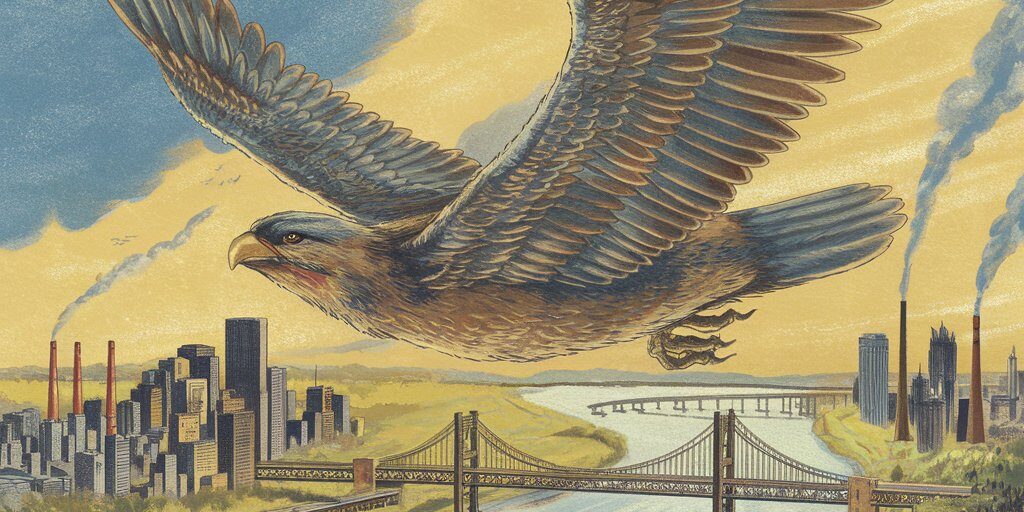Introduction: A Strange Chapter in Pittsburgh Folklore
In the annals of Pittsburgh’s folklore, few stories are as strange — or as persistent — as the tale of the Thunderbird sighting. Rooted in Native American mythology and echoed in 20th-century newspaper accounts, the legend of the Thunderbird is one of the city’s most curious historical mysteries.
Unlike modern urban myths, this story is part fact, part folklore, and part unsolved mystery. Reports of an enormous bird-like creature soaring over Western Pennsylvania sparked awe and fear, weaving themselves into Pittsburgh’s rich storytelling tradition.
The Native American Origins of the Thunderbird Myth
The Thunderbird is not unique to Pittsburgh — it originates in the legends of various Native American tribes, particularly the Algonquian-speaking peoples, who lived throughout the Ohio River Valley, including parts of Western Pennsylvania.
In these traditions:
- The Thunderbird was a supernatural being, often associated with storms and lightning.
- It was said to live atop mountains and carry out divine punishment.
- Sightings of the Thunderbird were considered omens of great change or disaster.
While the myth existed long before Europeans settled the region, it laid the foundation for later stories in Pittsburgh.
The 1940s Sightings: When the Legend Came Alive
The most well-documented and widely circulated Thunderbird incident in Pittsburgh took place in 1944. According to multiple newspaper reports, residents near South Side Pittsburgh and Allegheny County claimed to have seen a gigantic bird with a wingspan “large enough to block out the sun.”
Key Details from 1944 Reports:
- Described as looking like a “prehistoric bird” or “**giant condor.”
- Estimated wingspan: 15 to 20 feet.
- Sighted flying over Braddock, Clairton, and Monongahela.
One man, James Runco of Braddock, was quoted in local papers:
“It wasn’t like any bird I’ve ever seen. Bigger than a plane, it seemed.”
The story was picked up by the Pittsburgh Press and other local outlets, fueling speculation.
Scientific Theories and Skepticism
Many explanations have been offered over the years:
Misidentified Birds:
- Turkey vultures and condors can have large wingspans — up to 10 feet.
- Unusual flight patterns could cause misjudgments of size.
Escaped Exotic Animals:
- Some speculated that an exotic bird or even a military glider experiment was mistaken for a creature.
Ancient Survivor Theory:
- A fringe theory suggested it could be a surviving Pterosaur, though there’s no scientific evidence.
Skeptics argue mass hysteria or optical illusions may have played a role.
Other Notable Thunderbird Sightings in Western Pennsylvania
The 1944 Pittsburgh case is not isolated. Similar reports popped up across the region in the 20th century:
- 1930s: A group of schoolchildren near Beaver County reported seeing a giant bird.
- 1952: Another sighting in Westmoreland County, described as “a bird larger than a man.”
- 1970s: Reports resurfaced during the cryptid boom era, often grouped with Mothman and Bigfoot sightings.
Cultural Impact: The Thunderbird in Pittsburgh Lore
Despite skepticism, the Thunderbird story became part of Pittsburgh’s unique lore. It appeared in:
- Local history books and ghost story collections.
- Cryptid documentaries and websites.
- Folklore discussions linking Pittsburgh to national legends.
The myth intersects with the region’s larger story of Native American history, industrial boomtowns, and a landscape of vast rivers and sky-wide valleys, perfect for tall tales.
“In Pittsburgh, even our monsters are bigger than life.” — Local Historian, 1983
Legacy and Ongoing Mystery
To this day, no physical evidence of the Thunderbird exists. No photos, no remains — just stories passed down.
But the legend endures because it reflects something deep in the Pittsburgh psyche — a city built on the edge of wilderness, always staring into the unknown.
Is the Thunderbird just a myth? A misidentified bird? Or did something truly unexplainable soar over Pittsburgh skies during those war years?
That answer may never come, but the story remains one of Pittsburgh’s most fascinating and eerie historical footnotes.









